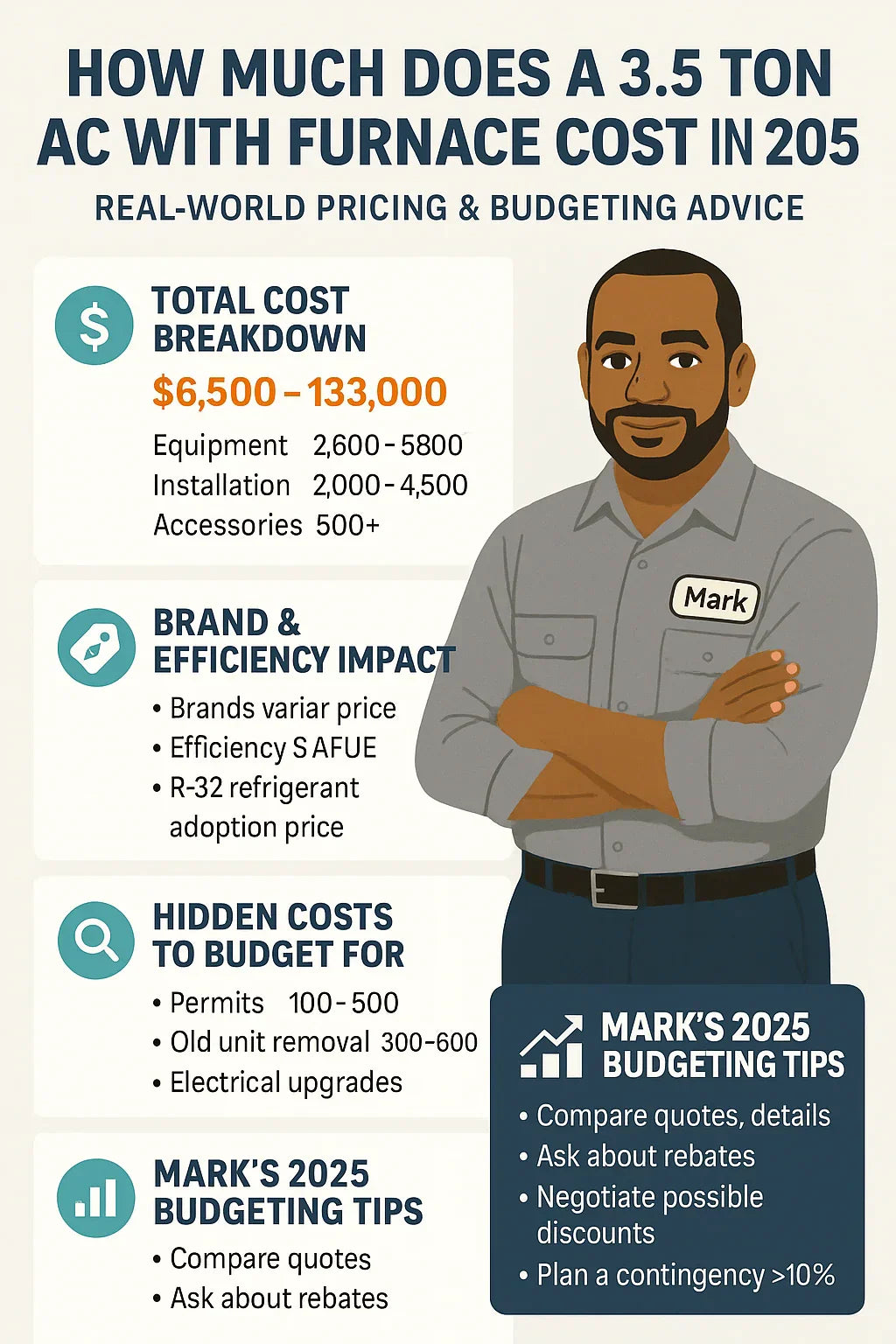🏠 Introduction: Why Pricing in 2025 Is a Moving Target
If you’re planning to buy a 3.5 ton air conditioner with a furnace this year, you’ll quickly discover that prices aren’t as straightforward as they used to be. In 2025, three big shifts are influencing HVAC costs:
-
R-32 refrigerant transition – Most new systems are now R-32 instead of R-410A, which changes both manufacturing costs and efficiency ratings.
-
Higher SEER2 requirements – The new efficiency testing standard has shifted the baseline, meaning older pricing references aren’t directly comparable.
-
Labor and supply chain changes – Technicians are in higher demand, and materials cost more to ship and stock than they did pre-2020.
As your practical guide, I (Mark) will break down real-world equipment costs, labor charges, hidden fees, and money-saving strategies—so you can budget with confidence and avoid sticker shock.
📦 1. Understanding What You’re Actually Buying
When you purchase a 3.5 ton AC + furnace combo, you’re paying for more than just a cooling unit. A complete package usually includes:
-
Outdoor AC condenser (3.5 ton capacity = ~42,000 BTUs)
-
Indoor evaporator coil matched to the condenser
-
Gas furnace (or electric furnace/air handler) sized to your home’s heating load
-
Basic thermostat (smart thermostats are an upgrade)
-
Line set, refrigerant, and installation materials
-
Labor to install, connect, and test the system
💰 2. 2025 Price Ranges for 3.5 Ton AC + Furnace Systems
Equipment-Only Costs
Prices vary by brand, efficiency, and refrigerant:
| Brand / Type | Equipment Only | Efficiency Range | Refrigerant |
|---|---|---|---|
| Goodman R-32 | $2,600–$4,200 | 14.3–17.2 SEER2 | R-32 |
| Carrier Comfort/Infinity | $2,800–$4,800 | 14.3–20 SEER2 | R-410A or R-32 |
| Lennox Elite/Signature | $3,200–$5,800 | 15–26 SEER2 | R-410A or R-32 |
| Trane XR/XL Series | $2,900–$5,500 | 14.3–22 SEER2 | R-410A |
| Amana High-Efficiency | $2,700–$4,500 | 15–19 SEER2 | R-32 |
Installed Costs (Typical U.S. Range)
A complete professional installation typically runs between $6,500 and $13,000, depending on:
-
Region and local labor rates
-
Efficiency level and refrigerant
-
Ductwork condition or need for modifications
-
Add-ons like zoning, advanced filtration, or smart thermostats
🛠 3. Labor & Installation Costs
Labor is a significant part of your budget, often $2,000–$4,500 for a straightforward swap. That cost can climb if:
-
The electrical panel needs upgrading (add $500–$1,500)
-
Ductwork requires sealing, resizing, or replacing ($1,000–$3,500)
-
You add accessories like UV lights, air purifiers, or zoning controls ($250–$1,200 each)
Even “free installation” offers often roll labor into the equipment price—so always request an itemized estimate.
📈 4. Efficiency Ratings & How They Impact Price
SEER2 for cooling and AFUE for furnace heating both directly affect your upfront cost and long-term bills.
-
14.3 SEER2 is the federal minimum in 2025 for most regions.
-
16–18 SEER2 units cost $800–$1,500 more but can save 15–30% annually on cooling costs.
-
Furnaces range from 80% AFUE (standard efficiency) to 97% AFUE (high efficiency). Higher AFUE models cost $600–$1,200 more, but save fuel in colder climates.
🌎 5. Regional Price Differences
Climate and location can swing your price range:
-
Hot, humid areas (Florida, Texas): Higher demand for AC, possible larger capacity needs → higher cooling efficiency premium.
-
Cold climates (Minnesota, New York): Furnace size and AFUE rating matter more; installation may require more venting and insulation work.
-
Mild climates (California coast): Mid-tier efficiency often balances cost and comfort.
Labor rates in urban areas can be 20–30% higher than rural averages.
🕵️ 6. Hidden Costs to Watch For
-
Permits & inspections: $100–$500
-
Old system removal & refrigerant recovery: $300–$600
-
Condensate pump replacement: $100–$300
-
Surge protection: $150–$250
-
Warranty upgrades: $100–$500 (extended coverage is worth considering for higher-end systems)
💡 7. Ways to Save on Your 3.5 Ton AC + Furnace
-
Claim rebates & incentives: Federal tax credits of up to $600 for qualifying systems, plus utility rebates ($100–$1,000 in some regions).
-
Off-season installation: Scheduling in spring or fall can lower labor rates.
-
Bundling services: Install AC and furnace together for package discounts.
-
Price match quotes: Many dealers will match or beat competitor offers if you show written estimates.
📋 8. Mark’s 2025 Budgeting Checklist
Here’s how I budget for major HVAC upgrades:
-
Get 3 quotes – from licensed, insured contractors.
-
Compare apples to apples – same SEER2, same AFUE, same accessories.
-
Ask for line-item pricing – equipment vs. labor vs. extras.
-
Check for rebates before buying – have your contractor help with forms.
-
Keep a 10% contingency fund – for surprises like duct or electrical fixes.
🔍 9. Long-Term Cost of Ownership
A high-efficiency 3.5 ton AC + furnace combo can save $150–$350 per year in energy compared to base models, meaning $1,500–$3,500 over 10 years—not counting rebates.
Regular maintenance ($125–$200/year) keeps efficiency high and avoids early breakdowns.
📊 10. Example Real-World Quotes (2025)
-
Mid-tier Goodman R-32, 15.2 SEER2 + 80% AFUE furnace: $7,200 installed in Ohio (basic swap).
-
High-efficiency Lennox, 18 SEER2 + 96% AFUE furnace: $10,900 installed in Illinois (minor duct adjustments).
-
Budget Carrier, 14.3 SEER2 + 80% AFUE furnace: $6,600 installed in Georgia (off-season special).
📎 Verified External References
✅ Conclusion
In 2025, a complete 3.5 ton AC + furnace system will generally cost between $6,500 and $13,000 installed, with higher-end models exceeding $14,000 when adding premium accessories and high-efficiency furnaces.
Key takeaway:
Don’t shop on tonnage alone—consider efficiency, refrigerant, regional factors, and available rebates. And always insist on itemized quotes so you know exactly where your money is going.
In the next topic we will read more about: Single-Stage vs. Two-Stage vs. Variable Speed: Which 3.5 Ton System Should You Choose?







